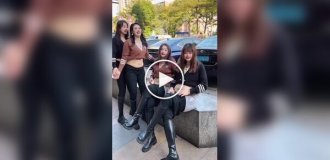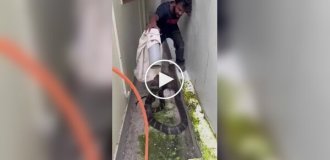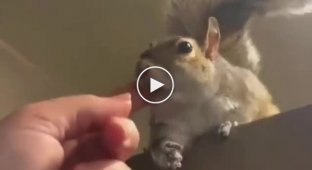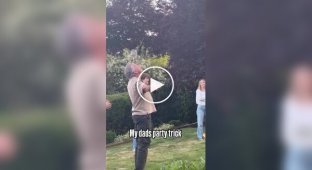The murder of Elizabeth Short - the "Black Dahlia" case (19 photos)
One of the most terrible and mysterious murders in the United States occurred back in 1947 and to this day makes everyone who gets acquainted with this case shudder. The fate of a girl who aspired to artistic fame, but became famous for her terrible death, is shocking in its tragedy. The story of Elizabeth Short, nicknamed the Black Dahlia, has been compared in cruelty to the victims of Jack the Ripper. The post DOES NOT CONTAIN photographs depicting the mutilated body of the girl.
The story began on January 15, 1947, when at 10-30 in the morning in Los Angeles, on the corner of 39th Street and Norton Avenue, local resident Betsy Bersinger, along with her 3-year-old daughter, noticed scattered parts of a mannequin on the ground in a park. However, as she came closer, she saw with horror that it was the corpse of a man.

The body, drained of blood and cut in half, belonged to a woman. The internal organs and blood were removed. A monstrous cut from ear to ear and numerous beatings disfigured the victim’s face. The murdered woman was not pregnant, and no signs of rape were found. The process of dismembering the girl, which was performed accurately, skillfully and using very sharp instruments, raised a lot of questions. Investigators immediately ruled out an ax and a saw, and leaned toward butcher's tools or surgical instruments. It was also suggested that the killer had special training.

Despite the almost complete absence of blood and huge wounds on the face, the police quickly determined the time of the crime - the first half of January 14, a day before the discovery of the body. Additionally, the victim was identified as Elizabeth Short. The police, based on an examination of the scene where the murdered woman was found, came to some obvious conclusions. The crime was committed in another place, and the body was taken to 39th Street already dismembered. Numerous manipulations were carried out with the body: tying, cutting, removing blood, the face of the murdered woman was mutilated to make identification difficult. The dismemberment itself was most likely carried out to facilitate transportation and was orderly in nature without signs of spontaneous anger.

The Betty Short Story.
Betty was born on July 29, 1924 in Massachusetts, to Phoebe and Cleo Short. The father left the family in 1929. At the age of 19, Betty moved to live with her father in Vallejo, California, but their relationship did not work out, and the girl moved to Santa Barbara. Here she leads a fairly free lifestyle and even gets arrested for drinking alcohol. Betty wants to become an actress, but so far she can only get work as a dishwasher and a model in a department store.

Continuing to visit nightclubs, in 1944 she met Major Matt Gordon, who led the Flying Tigers. He even proposed marriage to the girl. Matt served in the Philippines, and Betty returned to her mother in Medford, Massachusetts, to prepare for the wedding. After the end of World War II, Betty receives the sad news of the death of her lover during a flight to India.

Betty suffered the loss of her betrothed for several weeks, and then returned to Miami and began to lead a riotous lifestyle, often appearing in the company of various men, from war heroes to hardened criminals. However, Betty did not let anyone go beyond the paid dinner. Some researchers classify Betty as a woman of easy virtue, but no direct evidence has been obtained. Short spends all his and donated money on the most fashionable and stylish outfits, mostly black. In 1946, she moved to Southern California to live with Joseph Flicking, an Air Force lieutenant. They quickly separated and Flicking went to Carolina, where he became a civilian pilot. But correspondence continued between them; Joseph received the last letter from Betty a week before her death. During the last six months of her life, Betty moved frequently and changed her companions literally every evening.


Suspects in the Short case.
Betty had a very extensive circle of acquaintances in Hollywood. During the investigation, it turned out that the last person alive to see her was Robert Manley (trader, 25 years old), with whom the girl got into the car. Among the victim's other acquaintances were well-known figures in the film industry. So, French Tone, a film producer, even admitted his intentions to seduce the girl. However, she was unapproachable, as with most of the gentlemen whose names surfaced during the investigation.

Mark Hansen, the owner of a chain of nightlife establishments, also did not escape the charms of Elizabeth Short, however, like many, he did not get what he wanted. In addition, he noted that the girl was constantly surrounded by more and more gentlemen, with whom Betty behaved defiantly and ambiguously. Short deliberately exploited the image of a vamp, and her habit of dressing in all black and her love for dahlias led to the girl’s nickname - “Black Dahlia” (Black Dahlia).
Short's companion in the apartment, Barbara Lee, gave out a lot of information. She told the police about Betty's acquaintance with Georgette Bauerdorf, a wealthy Californian who was brutally murdered in her own swimming pool in 1945. This murder was never solved. After lengthy interrogations, the police identified the first real suspect, Robert Manley, who was the last to see the girl.

Manley was detained and interrogated for two days. The suspect did not deny the fact of acquaintance with the murdered woman, but claimed that he was rejected, like most of the fans. The last place he saw Elizabeth was at the Baltimore Hotel, where she asked for a ride, supposedly to meet her sister. Hotel staff confirmed that Short was at the hotel on January 9 and left on foot in an unknown direction. My sister was in Massachusetts at the time. Manley had to be released.

The police conducted an investigation for more than a year and checked more than 20 people for involvement in the murder. However, it was only in February 1948 that another real lead appeared - an anonymous letter with a colorful and detailed description of the murder. The police traced the letter and found Leslie Dillon, who was in California at the time of the murder and could have committed the crime. A whole staging was staged with the suspect being called to work in Nevada. At the same time, during the detention process, some American laws were violated, prohibiting the police of one state from working in the territory of other states.

During the arrest (without a warrant or the right to arrest), the suspect was transported in the trunk of a car from Las Vegas to California, where he was kept in a hotel. However, unfortunate Dillon managed to throw a note out of the toilet window, in which he called... the police for help. The hotel was surrounded and stormed. The inconsistency in the work of the structures came to light, and Dillon turned out to be a trivial schizophrenic, impressed by newspaper articles about the death of a girl.

At this time, in the winter of 1948, another interesting version appears. An informant reported to the police officer that petty criminal Al Morrison had talked about the brutal murder of a girl with a black ribbon around her neck (this detail added credibility, since Short was wearing such a ribbon before her death). The information was passed on to Sergeant Harry Hansen, who is leading the investigation. Based on the information received, the murder scene was a hotel on the corner of 31st and Trinity Streets.

The informant spoke in detail, according to the criminal, about the rape, murder and dismemberment of the body. After presenting the informant with a number of photographs, he confidently identified Al Morrison, who was also known as Arnold Smith, aka Jack Anderson Wilson. An important detail also emerged - Morrison had already been interrogated in the murder of Georgette Bauerdorf, an acquaintance of E. Short.

The police decided to carry out a cunning operation to detain the suspect Wilson-Smith-Morrison, but several times he managed to evade his pursuers, either on a whim, or by chance. But in the end, fate played a cruel joke on Morrison; he burned to death in his hotel room, falling asleep with a lit cigarette.
It seemed that the matter had reached a dead end. But at this time, the police checked the version of the search for the location of Short's murder, combing the buildings surrounding the place where the body was found. Unexpectedly, the police found Walter Bailey, who had previously been accused of sexual assault. He and his wife owned a house at 3959 Norton Avenue, a block from where Short was found dead.

Previously, Walter Bailey was a very successful practicing physician, lectured at the University of California and headed a hospital. However, in 1946, several nurses made claims of sexual harassment against Dr. Bailey. As a result, his wife left him, he lost his position as head physician and the right to teach at the university. Bailey even had to marry one of the young nurses, but this did not save his tarnished reputation. Bailey's house at 3959 Norton Avenue was vacant at the time, but had been renovated. And the doctor himself was there periodically. The availability of space, surgical practice and Bailey's bad reputation simply obliged the police to check this version. But even here the investigators were plagued by failure - the police who came for questioning discovered a half-crazed old man suffering from Alzheimer's disease.

70 years have passed since then, during which time fifty versions have been put forward, thousands of documents have been verified and testimonies of hundreds of witnesses have been taken. Short's case was surrounded by myths, for example, about her acquaintance with Monroe and Reagan (not confirmed). Videos appeared with the heroine surrounded by unknown people. However, a 460-page book by retired homicide detective Steve Hodel, published in 1995, became a sensation.

The author claimed to know who committed the murder of E. Short. However, the surprises did not end there - Steve Hodel suggested that 20 more girls across the United States became victims. Moreover, the killer was identified as the author's own father - George Hodel.
The hero of the investigation was a fairly talented person - an author of literary works, a poet, a musician and even a journalist in the crime genre. George Hodel was the founder of the venereology clinic. At the same time, he turned out to be a lover of beautiful women, among whom was Elizabeth Short. Photos from a family album were even presented. The study's author's father first came to the attention of the police when, in 1949, his daughter accused her father of sexual abuse. Also, 14-year-old daughter Tamar accused her father of murdering Short.
In December 1949, a trial took place in which Dorothy Hodel's mother accused her daughter of slander and claimed that her daughter was mentally ill and a clinical liar. The court's verdict, handed down on December 23, was unexpected: all those accused of Tamar Hodel were cleared of suspicion, while Tamar herself was declared a victim of deliberate manipulation by... 22-year-old Barbara Sherman, one of the three prosecution witnesses.

Analyzing the trial, the defendant's son claims manipulation of the police by his father, George Hodel. The police warned about the installation of listening equipment in his house and carried out explanatory work with witnesses. However, even the successful outcome of the case did not save Hodel’s reputation; he left the city and returned only 30 years later in 1979. The character accused by his son died in 1999 in a state of deep insanity.
As a result of comparing the psychological profile of the killer and George Hodel, the police found some discrepancies and similarities, but at the moment there is no clear conclusion. Let us note the impact of the death of Betty Short on the legislation of the state of California - from that moment on, all sex offenders are subject to mandatory registration.






















